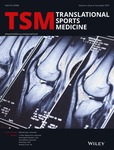Resting metabolic rate and blood lipid changes of an experienced backpacker hiking the Appalachian Trail
Abstract
Objective
To evaluate the effects of a long-distance backpacking trip on resting metabolic rate, body composition, weight, and blood lipid profile.
Methods
Single-subject (male, aged 61 years) study of an experienced backpacker who hiked 151 days on the Appalachian Trail. Resting metabolic rate (RMR) was measured pre- and post-hike, body composition was assessed pre-, mid-, and post-hike and blood lipids were measured pre-, early-, mid-, and post-hike.
Results
Pre-post differences showed decreases in body fat (−12.2% [−39%]) and body weight (−21.32 kg [−23%]). Changes associated with RMR showed decline in RMR 24 hours (kcal; −124 [−7%]), increase in both RMR 24 hours kcal/total mass (+3.79 [+21%]) and RMR 24 hours kcal/lean mass (+0.75 [+3%]), and change in respiratory exchange ratio (RER) from 0.92 to 0.83. Pre-post differences in blood lipids were as follows: triglycerides (TG; −499 mg/dL [−84%]); total cholesterol (TC; −131 mg/dL [−43%]); high-density lipoprotein cholesterol (HDL-C; +17 mg/dL [+44%]); low-density lipoprotein cholesterol (LDL-C; −46 mg/dL [−33%]); LDL-C/HDL-C ratio (−1.92 [−53%]); and TC/HDL-C ratio (−4.69 [−61%]).
Conclusion
The physical activity associated with an extended backpacking adventure can very positively impact resting metabolic rate, body composition, weight, blood lipids, and lipoproteins.
CONFLICT OF INTEREST
The authors declare no conflict of interest.




